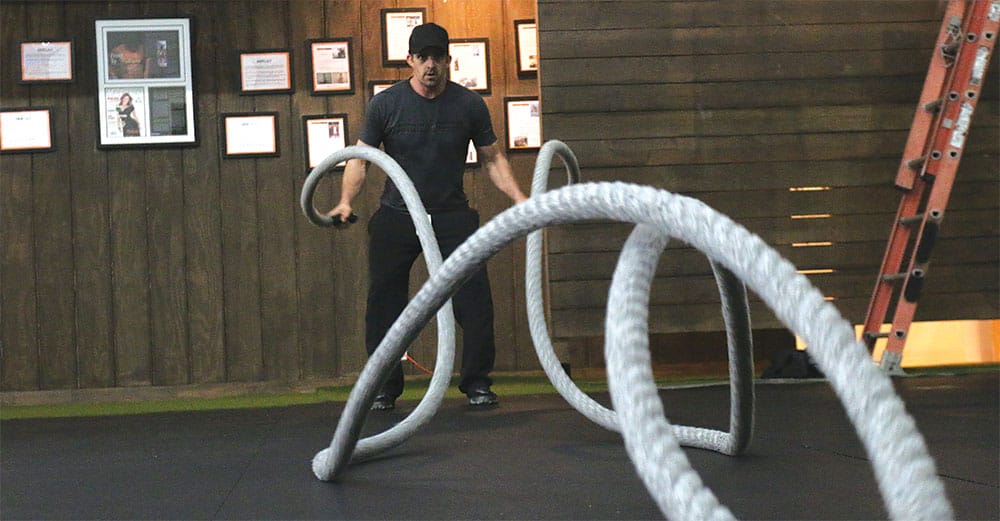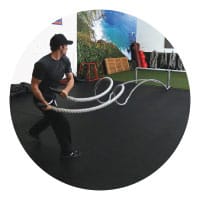Battle Rope Training for Grapplers

Heavy ropes training has been a pretty hot topic in the fitness world for the last few years. A once unique tool that caught people’s eye, now everywhere from commercials to UFC highlight films. My goal in this article to explain the basics and show you some of the advanced techniques that we have been using at our gym over the last few years.
Developed by John Brookfield, the Battle Ropes system is incredible, versatile and powerful. The ropes can be manipulated for various training goals to accommodate a wide variety of people. Over the past few years I have seen physical therapists use them with patients, coaches use them with elite athletes and everyone else in between. The cool part about the ropes is that there is almost zero risk for injury, very little learning curve and it is a stimulus that is unlike anything else.
3 Keys To Rope Training
Relax – learning to relax under stress is vital. So many people grip the ropes hard and tense up their body which leads to quick exhaustion. Grip the rope lightly, relax your arms, shoulders, torso, and even your face. You will be able to move faster and maintain intensity for longer periods of time.

Breath – This goes hand and hand with being able to relax. Rope exercises are 100% output, meaning there is no rest. Typical exercises have a rest point, that allow relaxation and consistent breathing patterns. Novices to rope training hold their breath and hurt their performance. Try and match your movement with your breathing pattern. As speed and intensity increases, your breathing should match.
Use your whole body – While most rope exercises are thought to be upper body movements, the entire body should be utilized to increase power and efficiency. The legs and hips play a very important role in generating power into and through the arms. This is important for all movements, especially sports and athletics. When doing the waves, be conscious of your feet, legs, hips, and shoulders. Make sure not to stand to stiff and make sure that all areas of your body are active.


Benefits of Rope Training
Learning to maintain intensity over time helps increase lactic acid threshold in your upper body. This is very unique, since the majority of conditioning these days focuses on locomotion, running, climbing, and other drills propelled by the legs. This has helped us all with our other lifts and activities outside the gym. It has also become one of our secret weapons when training MMA fighters. I expect each one of them to be able to maintain intensity on a variety of rope drills for at least 5 minutes.
They are fun. The majority of people that I talk to hate the gym and its not because they are lazy. Most people are seriously bored at the typical big box gym. There is no emotion and very little has changed over the last 30 years. Using tools like the ropes is a breath of fresh air for most people, it creates excitement, is unique, and gets people “playing” again.

Developing mental toughness. I think that developing mental toughness and learning to overcome obstacles is one of the most important things we can help people do. When people start using the ropes, the idea of maintaining intesntiy over 1 minute seems like a pipe dream, but consistent training will help them breakthrough mental barriers and come out with a new outlook and confidence.
Unilateral dominance/imbalance – The waves tell a story. If you watch carefully on the movements, you will notice that your left side (or right) may move differently than the right. It may have a smaller wave or be uncoordinated or a variety of other things, but the cool part is that, over time, these differences go away. Slowly, you will notice right and left start to balance out.

The Wave Series
The Wave Series is typically what you see on Youtube, commercials and advertisements. The most challenging aspect of the wave series is that, if done correctly, the exercises have zero downtime…it is 100% work!
These exercises can be used in circuits, intervals or distance. A 50’ rope, wrapped around an anchor, makes 2 – 25 foot lengths. You can use this information to design distance workouts (1/4 mile, 1 mile, etc). Time, distance, reps, etc can all be manipulated to a variety of workouts and goals. The possibilities are only limited by your imagination. Use the following variables to increase or decrease each exercise to fit your clients ability levels and goals.
Here are 6 wave exercises, each stressing the body in different ways, using different muscles.

Make It Harder
5 ways to adjust intensity when using the wave series (exercise variables for the ropes)
1. The Handle – Fold the rope over and it doubles the size of the rope you have to hold, making it more challenging on the grip.

2. Distance from the Anchor – Ideally you start with a little slack on the ropes. By moving closer to the anchor point, it makes it more challenging to get the waves to the end. So you’ll have to generate more power through the rope to get it all the way down.

3. Body Position – Standing, kneeling, sitting, plank and moving while doing various waves adds a whole new list of ideas. As you go from standing to kneeling, less of the body is able to work and it becomes more difficult to get the waves to the end. Adding a variety of movement (squatting, lunging, jumping, lateral movement and more) can make a basic movement very challenging.

4. Size of the Rope – Typically we use a 50’ rope that is 1.5” thick for the wave series. There is also 2” rope available, but because of its added girth and weight, it is much more difficult.

5. Wave Size/Velocity/Pace – The size and speed of the waves can also be counted. This is really no different than pacing yourself for kettlebell lifting or running. The faster you go, the harder and more intense it becomes. Try to maintain 120-150 alternate waves per minute and see how you fair.
When trying the waves for the first time, 20 seconds will feel like an eternity. Over time, people quickly adapt and can maintain consistent pace and intensity for 5 minutes – 45 minutes plus. Slowly adding volume over time will build your work capacity, allowing you to push at a faster pace, for longer periods of time.
Challenges:
#1 100’ (1.5” rope) tsunami wave. Part one of this challenge is being able to generate enough power to get a wave down the rope to the anchor point. If you can do that, then see how long you can maintain waves to the anchor.

#2 50’ (1.5”) alternating waves. A simple start is to keep the waves going to the anchor for 5 minutes. You don’t need to worry about speed or intensity…just keep the waves going to the end for 5 minutes.

#3 Rope Taz – Start by unhooking the rope from the anchor point. You should have a good amount of open space for this drill. Simply take both hands and slam the rope quickly up and down. This is similar to the stagecoach or double handed waves, but you will have to move laterally to avoid the rope. Try and keep the entire length of the rope moving. How long can you keep the entire rope moving?


The Pull Series
I rarely see anyone talk about these drills, but they are one of our favorites for jiu-jitsu practitioners. They are simple, effective and truly humbling. These drills will tax your grip, arms, shoulders, back, and core like no other.
Here are three pulling exercises to use with your rope.

Change It Up
5 Ways to Add Variety to Your Pulls
1. Body Position: Standing, kneeling, seated, plank; these positions don’t work for every pull mentioned, but do for most. As you attempt the various pulls, you will know right away which one works or not.

2. Size of Rope – The size of the ropes is a huge component of these drills. The increased girth, makes gripping the rope more difficult. For some of the testing we do, men use the 2” ropes, while women use the 1.5”. A larger rope also weighs down on itself when piled up, so you will feel some natural resistance during the pull.
3. Length of Rope – Ideally you will use a 100’ rope for all the pulling exercises. Not only do you have to change less often, but the increased length also piles on itself as mentioned before. This type of resistance is inconsistent and forces you to overcome little bumps along the way. Enjoy!
4. # of Wraps – Varying the resistance is as simple, as wrapping the rope around the pole more or less. One wrap is a good start, but you can add wraps as you see fit.

5. Time or Distance – We use the pulls in a variety of ways, including timed intervals, distances and more. Just like the waves, you are able to determine distance very easily. Want to pull a mile? 53 lengths of a 100’ rope is about a mile.
The pull series offers another way to challenge your entire body. It is definitely one of my favorite drills and I use some variation of this at least once per week for myself and my clients. It is perfect for grapplers, but also very effective for anyone looking to develop more upper body strength.
Challenges
#1 How many lengths can you pull in 10 minutes? Compete with your teammates, push your limits and continually raise the bar. Get good at this challenge and your arms will never falter during a match.
#2 How many wraps can you pull. Adding 2 wraps can drastically increase the difficulty. Work to add more wraps and see what you can handle, but be careful. Ropes are much different than handles, so for an untrained hand, these can be tough. Start slow, maintain good posture and increase intensity over time.
#3 The Buffett – Choose 4 different pulls and do each for a quarter mile, back to back. It will total one mile (53 lengths with 100’ rope). Try and complete the drill under one hour.
The End of your Rope
As you can see battle ropes offer a wide variety of drills that can yield huge benefits for combat athletes. The wave drills increase work capacity, improve cardio, strength, and your endurance. The pulling drills help build strength in your grip, arms, shoulders, back and core. Used correctly, these drills will help take your strength and conditioning to new heights.
